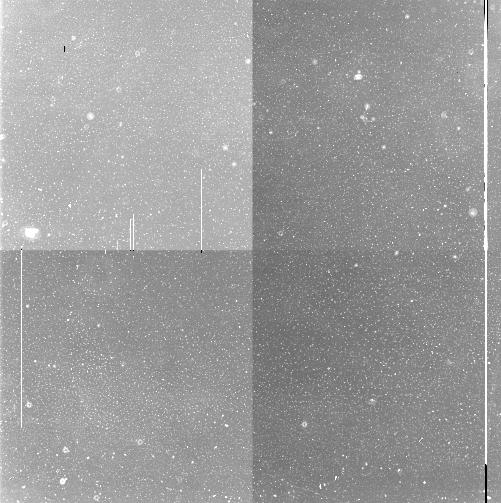Tek2K
Read more about NOIRLab's instruments and other capabilities in the Capabilities brochure.
Tek2K is a 2K optical CCD imager installed on the SMARTS 0.9-meter telescope that provides a 13.6 arcminute field of view with 0.4 arcsecond pixels. Key capabilities of the imaging system at the 0.9-m can be found at http://www.astro.gsu.edu/~thenry/SMARTS/0.9m.capabilities.
| Detector Parameters (f/13.5) | |
| Pixels | 2048x2046 |
| Pixel Scale | 0.401"/pixel |
| Field Size | 13.6'x13.6' |
CCD Parameters
The observer can control and change the CCD readout format and binning. The entire chip can be read out via a single amplifier, or to reduce the readout time, two (DUAL mode) or four (QUAD mode) amplifiers can be used. The region-of-interest (ROI) can also be adjusted to use an arbitrary section of the CCD. Observers should think carefully about whether or not they need the entire field (if not, read a ROI) or the resolution (if not, bin 2x2) because substantial gains in efficiency are possible by reducing the format or increasing the bin size.
A raw quad-amplifier picture looks a little unusual. Each quadrant has a slightly different electrical offset (ie overscan level), and the four overscan segments are in the center of the picture. The real time display colors any saturated (i.e., 65535 ADUs) pixel in red.
QUAD CCD pictures have to be trimmed and overscan-subtracted in a separate pre-processing IRAF task called quadproc (in the quad package). Note that even after the pictures are trimmed and overscan subtracted, the sky levels in each quadrant will not be identical (unless the sky level is zero). This is because each of the four CCD amplifiers has a slightly different gain. After the trimming and overscan correction with quadproc, the images can be processed (bias subtraction, flatfielding) in the standard manner.
Data Acquisition Procedures
A night assistant is not provided at the SMARTS 0.9-meter telescope. An Observer's Manual, including details about the telescope, instrument, telescope control system, and data acquistion system is provided in the observing room and at http://www.astro.gsu.edu/~thenry/SMARTS/.
Sky flats and dome flats can be taken. Dome flat exposure times to reach a level of about 25,000 ADU are:
| Filter | Exp Time (sec) |
| B | 180 |
| V | 100 |
| R | 110 |
| I | 120 |
| A sample "master" Bias frame (quad readout) after overscan correction and trimming with quadproc (click on the image for an expanded view). The frame was created by averaging 20 individual frames (rejection option "minmax"). | |
| A sample "master" Flatfield frame (quad readout, V filter) after overscan correction and trimming with quadproc (click on the image for an expanded view). The frame was created by median combining 10 individual frames (rejection option "avsigclip"). |
Crosstalk
When using multiple-amplifier readout, the signal from one amplifier can "leak" into the signal of another. Crosstalk is an additive effect and is proportional to the signal strength in a given amplifier. In the sample frame shown below, this effect shows up as negative (white) images of bright stars in the lower left and upper right quadrants. The white images in the upper right quadrant correspond to the (black) star images of the lower left quadrant (flip the upper right quadrant left-right and up-down).
Updated on January 18, 2023, 9:32 am


